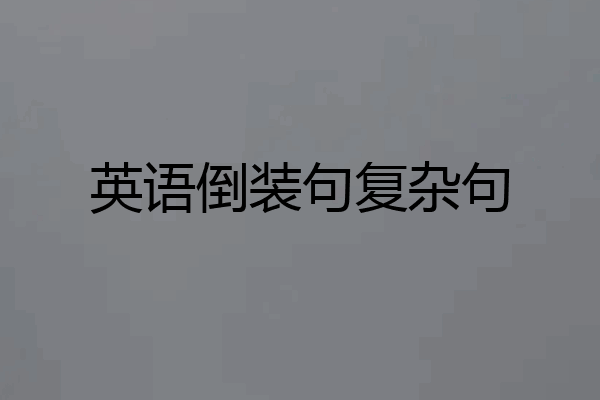
号仔在厦门
一、全部倒装
全部倒装是只将句子中的谓语动词全部置于主语之前。此结构通常只用与一般现在时和一般过去时。常见的结构有:
1)here,there,now,then,thus等副词置于句首,谓语动词常用be,come,go,lie,run.
There goes the bell.
铃响了。
2)表示运动方向的副词或地点状语置于句首,谓语表示运动的动词。
Out rushed a missile fromunder the bomber.
导弹从轰炸机下面冲了出来。
二、部分倒装
部分倒装是指将谓语的一部分如助动词或情态倒装至主语之前。如果句中的谓语没有助动词或情态动词,则需添加助动词do,does或did,并将其置于主语之前。
1)句首为否定或半否定的词语,如no,not,never,seldom,little,hardly,at no time,in no way,not until&hellip等。
Neverhave I seen such a performance.
我从未见过这样的表演。
三、以否定词开头作部分倒装
如Not only…but also,Hardly/Scarcely…when,No sooner… than
Not only did he refuse thegift,he also severelycriticized the sender.
他不仅拒绝了礼物,还严厉的批评了送礼的人。


小猪行天下1212
英语倒装句是为了强调、突出等词语的目的而颠倒原有语序的句式。
英语最基本的语序是主语在前,谓语动词在后。但有时由于句子结构的需要或表示强调,就要采用倒装形式。英语倒装分为完全倒装和部分倒装,完全倒装(Full Inversion)即为谓语部分完全放在主语之前,如:Now comes your turn;部分倒装(Partial Inversion)即把助动词、情态动词、be动词置于主语之前。
英语倒装句的例句
1、Not only did he come,but also he brought us good news.
他不但来了,而且给我们带来了好消息。
2、Only Li Lei can answer this question.
只有李蕾能回答这个问题。
3、May you have a good journey.
祝你旅途愉快。

KP-bangbangbang
I. 完全倒装 1. 用于 there be 句型. 2. 用于“ here ( there, now, then )+不及物动词+主语”的句型中,或以 in, out, up, down, away 等副词开头的句子里,以表示强调. 注意: ( 1 )主语是代词时,主语和谓语不倒装. ( 2 ) here , there 放在句首通常用一般现在时. 3. 当句首状语为表示地点的介词词组. 4. 表语置于句首时,倒装结构为“表语+连系动词+主语”: ( 1 )形容词+连系动词+主语 Present at the meeting were Mr Li, Mr Wang and many other teachers. 出席会议的有李老师、王老师和其他很多老师. ( 2 )过去分词+连系动词+主语 Gone are the days when we used foreign oil. 我们使用洋油的日子一去不复返了. ( 3 )介词短语+ be +主语 Among the goods are books, exercise-books, pens and some other things. 在所有的货物中有书、练习册、钢笔和其他东西. 5. 用于 so, neither , nor 开头的句子,表示重复前句的部分内容.原句的谓语应与前句的谓语的时态、形式相一致. 例如:You can't speak French. Neither can she. 你不会说法语,她也不会. 6. 为了保持句子平衡,或为了强调表语或状语,或是上下文紧密衔接时. 例如: They arrived at a small village, in front of which was a big river. 他们来到一个小村庄,村庄前面是条大河. II. 部分倒装 1. 用于疑问句. 例如: Do they work in the factory? 他们在这家工厂上班吗? 2. 用于省略的虚拟条件状语从句. 例如: Had I seen him yesterday wouldn't go to his house now. 如果我昨天见到他了,我现在就不去他家了. 3. 用于“形容词(或名词、动词) +as ( though )”引导的让步状语从句中.例如: Try as he would, he might failed again. 他虽然可以试试,可能还会失败. 注意:如果从句的表语是名词,其名词前无形容词时,不用冠词;若有形容词要用冠词. Child as he was, he had to make a living. 他虽是个孩子,但得糊口. 4. 用于 no sooner … than … , hardly … when 和 not until 等句型. No sooner had I come in, the telephone rang. 我刚进屋,电话铃就响了. 5. 用于 never, hardly , seldom, scarcely, barely, little, at no time, not only 等开头的句子. Seldom does he come late. 他很少迟到. 6. 用于“ only +状语”开头的句子. Only then did he know he was wrong. 直到那时他才知道他错了. 7. 用于“ so +形容词 / 副词”放在句首的 so … that 句子. So fast is he running that he can keep up with the bike. 他跑得快得能跟上自行车.
优质英语培训问答知识库